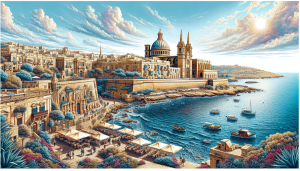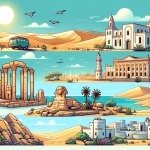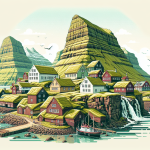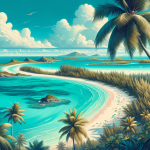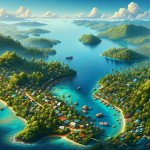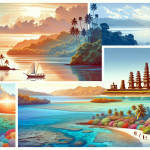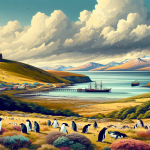Discovering Malta: A Mediterranean Gem
Malta, an archipelago nestled in the heart of the Mediterranean Sea, is a treasure trove of history, culture, and natural beauty. This small but mighty nation, comprising three main islands – Malta, Gozo, and Comino – offers a plethora of experiences for travelers. From its stunning beaches and crystal-clear waters to its rich heritage and vibrant nightlife, Malta has something for everyone. Whether you’re a history buff eager to explore ancient sites, a nature enthusiast looking to dive into marine adventures, or a foodie craving Mediterranean flavors, Malta won’t disappoint. In this blog post, we’ll delve into the many facets of this enchanting destination, uncovering the hidden gems and must-see attractions that make Malta a top choice for travelers worldwide.
The Rich History of Malta
Malta’s history spans over 7,000 years, making it one of the most historically rich places in the world. The islands have been influenced by various civilizations, including the Phoenicians, Romans, Arabs, Normans, and the Knights of St. John, each leaving an indelible mark on Malta’s cultural landscape.
The Megalithic Temples
One of Malta’s most fascinating historical features is its Megalithic Temples, which are among the oldest free-standing structures in the world. Sites like Ġgantija Temples on Gozo and Ħaġar Qim and Mnajdra on the main island date back to around 3600 BC. These temples are a testament to the advanced engineering skills and the spiritual life of Malta’s ancient inhabitants.
The Knights of St. John
The Knights of St. John played a significant role in shaping Malta’s history. Arriving in 1530, these warrior monks transformed the islands into a formidable bastion of Christianity. Their legacy is most evident in Valletta, the capital city, which they founded in 1566. Valletta, a UNESCO World Heritage site, is a living museum with its fortifications, baroque architecture, and the stunning St. John’s Co-Cathedral.
World War II
Malta’s strategic location made it a focal point during World War II. The islands endured intense bombing campaigns, earning the entire population the George Cross for bravery. The Lascaris War Rooms and the Malta at War Museum in Vittoriosa provide a poignant insight into Malta’s wartime experiences.
Natural Beauty and Outdoor Activities
Malta’s natural landscapes are as diverse as they are beautiful. From rolling hills and rugged cliffs to serene beaches and azure waters, Malta is a paradise for outdoor enthusiasts.
Beaches and Blue Lagoons
Malta boasts some of the most stunning beaches in the Mediterranean. Golden Bay, Mellieħa Bay, and Paradise Bay are just a few of the sandy shores where you can soak up the sun. For a truly unique experience, head to the Blue Lagoon on Comino. This idyllic spot, with its turquoise waters and white sandy bottom, is perfect for swimming, snorkeling, and diving.
Hiking and Nature Trails
If you prefer land-based activities, Malta offers a variety of hiking and nature trails. The Dingli Cliffs, located on the western coast, provide breathtaking views of the Mediterranean Sea. The Victoria Lines, a series of fortifications crossing the island, offer a scenic route for walkers. On Gozo, the Ta’ Ċenċ Cliffs and the Sanap Cliffs are must-visit spots for nature lovers.
Diving and Water Sports
Malta is a diver’s paradise, with numerous dive sites featuring underwater caves, shipwrecks, and vibrant marine life. Cirkewwa, Blue Hole, and Inland Sea are popular dive spots. For those seeking adrenaline-pumping activities, Malta offers windsurfing, kitesurfing, and jet-skiing opportunities.
Maltese Cuisine: A Culinary Journey
Maltese cuisine is a delightful blend of Mediterranean flavors, influenced by the various cultures that have settled on the islands over the centuries. From fresh seafood to hearty stews, Malta’s culinary scene is a treat for the taste buds.
Traditional Dishes
Some traditional Maltese dishes you must try include:
- Pastizzi: Flaky pastry filled with ricotta cheese or mushy peas.
- Fenkata: A rabbit stew that is considered Malta’s national dish.
- Lampuki Pie: A savory pie made with lampuki fish, spinach, and vegetables.
- Hobz biz-Zejt: Maltese bread dipped in olive oil and topped with tomatoes, capers, and anchovies.
Local Markets and Street Food
To experience Malta’s culinary culture, visit local markets like the Marsaxlokk Fish Market or the Valletta Food Market. Street food vendors offer a variety of snacks, including qassatat (savory pies) and imqaret (date-filled pastries).
Fine Dining
For a more upscale dining experience, Malta boasts several Michelin-starred restaurants. Noni in Valletta and Under Grain are renowned for their innovative menus and exquisite presentations.
Vibrant Nightlife and Festivals
Malta’s nightlife scene is vibrant and varied, catering to all tastes and preferences. From lively nightclubs to cultural festivals, there’s always something happening on the islands.
Nightclubs and Bars
Paceville in St. Julian’s is the epicenter of Malta’s nightlife, with numerous bars, clubs, and lounges. Whether you’re into dancing till dawn or enjoying a quiet drink, Paceville has it all. Sky Club, Havana, and Footloose are popular spots to dance the night away.
Cultural Festivals
Malta hosts a variety of cultural festivals throughout the year. The Malta International Arts Festival and the Valletta Film Festival attract artists and filmmakers from around the world. Traditional festas, celebrating patron saints with fireworks, music, and food, are also a quintessential part of Maltese culture.
Live Music and Entertainment
For live music enthusiasts, Malta offers a range of venues hosting local and international artists. Gianpula Village in Rabat is a popular open-air club featuring live DJ performances. Teatru Manoel in Valletta is one of the oldest working theaters in Europe, offering a range of performances from classical music to contemporary theater.
Shopping in Malta
From bustling markets to chic boutiques, Malta offers a variety of shopping experiences. Whether you’re looking for traditional crafts, designer brands, or unique souvenirs, you’ll find it all here.
Valletta and Sliema
Valletta and Sliema are the main shopping hubs in Malta. Republic Street and Merchant Street in Valletta are lined with shops selling everything from fashion to antiques. In Sliema, the Tigne Point Shopping Mall offers a range of international brands.
Local Crafts and Souvenirs
For unique souvenirs, visit local craft shops and markets. Ta’ Qali Crafts Village is a great place to find handmade pottery, glassware, and lace. Maltese filigree jewelry is also a popular choice.
Flea Markets
If you enjoy bargain hunting, don’t miss the Birgu Flea Market held every Sunday. Here, you can find a variety of vintage items, antiques, and collectibles.
Practical Information for Travelers
Before you embark on your Maltese adventure, here are some practical tips to help you make the most of your trip.
Getting There and Around
Malta International Airport (MLA) is the main gateway to the islands, with flights connecting to major cities across Europe. Once in Malta, you can get around using public buses, taxis, or car rentals. The Gozo Channel Ferry provides regular services between Malta and Gozo.
Best Time to Visit
The best time to visit Malta is during the spring (April to June) and autumn (September to November) when the weather is pleasant, and the tourist crowds are smaller. Summer (July to August) is the peak tourist season, with hot weather and various festivals.
Accommodation
Malta offers a range of accommodation options to suit all budgets. From luxury hotels and boutique guesthouses to budget hostels and self-catering apartments, you’ll find something to fit your needs. Popular areas to stay include Valletta, St. Julian’s, and Mdina.
Health and Safety
Malta is generally a safe destination for travelers. The healthcare system is of a high standard, with both public and private hospitals available. Tap water is safe to drink, but bottled water is also widely available.
Language and Currency
Maltese and English are the official languages, making it easy for English-speaking travelers to communicate. The currency used is the Euro (€). Credit cards are widely accepted, but it’s always a good idea to carry some cash for small purchases.
Conclusion
Malta, with its rich history, stunning landscapes, and vibrant culture, is a destination that promises a memorable experience for every traveler. Whether you’re exploring ancient ruins, lounging on beautiful beaches, savoring local delicacies, or dancing the night away, Malta captivates and enchants. So, pack your bags and get ready to discover this Mediterranean gem.
For a deeper dive into Malta’s offerings, check out Visit Malta for more information and travel tips.
